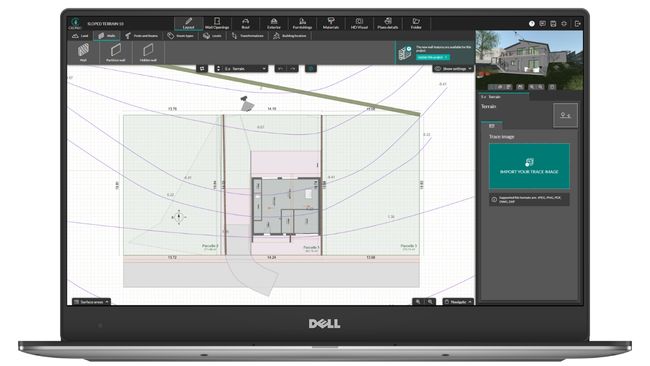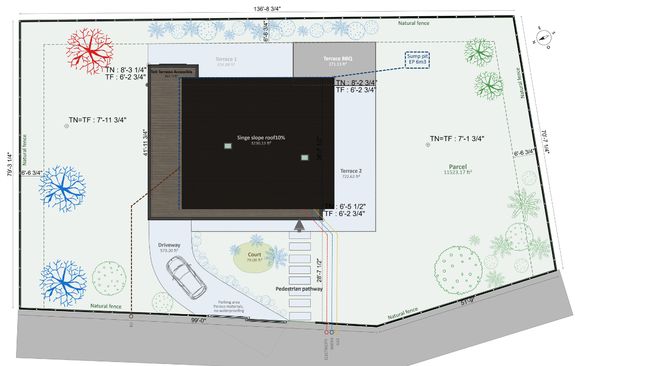One document is the foundation of any successful renovation or home improvement project: the site plan. Imagine planning a beautiful new deck or garden without knowing your property lines or trying to get necessary permits for a home addition without understanding where utility lines run.
Obtaining a site plan of a property is crucial for anyone looking to make improvements or understand the property better before creating a home remodel design. A site plan review process is often required by local government agencies before approving construction projects.
Where to Find a Site Plan
You may find a copy of your site plan for your property in a few ways.
Closing Documents From a Property Sale
Check the closing documents from when you purchased your property. These thick packets of paperwork often contain a survey or site plan required for the sale.
Local Government Office
Your local government offices contain historical property information. The planning or zoning department maintains records of property surveys and site plans, particularly if any permits were pulled for construction or improvements. Many counties now offer digital access to these records through their websites, including county parcel maps and GIS information.
Remember that there will likely be a nominal fee for accessing public records. The exact price will vary by state and county, but you can generally expect:
- Paper copies cost $0.25 to $0.50 per page
- $0.50 for black and white digital scans
- $10 to $30 for color, high-resolution scans, depending on size.
Online access to records may come with different fee structures. Contact your local county government office for more clarity.
Local Courthouse – Title Report
Your local courthouse should have a copy of your property’s title report, which often includes a site plan. The title report is a document that contains the legal status of your property and related information about its ownership. You can find contact information for your local courthouse online, and many courthouses now offer digital access to these records. Some courthouses may charge a small fee for accessing or copying these documents, so it’s best to check with them directly about their specific procedures and costs.
County Tax Assessor Office
County tax assessor offices maintain detailed records of properties for tax purposes. While these records might not include full site plans, they often contain valuable information about your property’s dimensions and existing structures. You’ll need your property’s parcel number or address to access these records. Some assessor’s offices even provide Geographic Information System (GIS) maps that show detailed property information, including boundaries, topography, and existing structures.
Title companies
If you’re having trouble locating a copy of your site plan through these sources, title companies can be surprisingly helpful. The title company that handled your property purchase likely has copies of all documents related to your property, including site plans. While they might charge a small fee for copies, their records are typically well-organized and easily accessible.
State-by-State Site Plan Locator
Locating a copy of your site plan might seem daunting, but every state maintains these vital records – it’s just a matter of knowing where to look. While the table below provides specific resources for major metropolitan areas, the process remains similar whether you live in a bustling city or a rural community.
Below is a chart on how to find a site plan in your state.
| State | Primary Resource | Additional Tips |
| Alabama | County Probate Office | Request property card first, then site plan |
| Alaska | Borough/Municipality Office | Most records since 1985 are digitized |
| Arizona | County Assessor’s Office | Search by parcel number for fastest results |
| Arkansas | County Clerk’s Office | Call ahead – many offices require appointment |
| California | County Recorder’s Office | Check city planning department first |
| Colorado | County Assessor | Most metro areas have online portals |
| Connecticut | Town Clerk’s Office | Most towns require in-person requests |
| Delaware | County Land Use Department | State maintains central database |
| Florida | Property Appraiser’s Office | Most counties have GIS information portals |
| Georgia | County Tax Assessor | Request property card with site plan |
| Hawaii | County Planning Department | Records vary by island |
| Idaho | County Assessor | Most rural counties require visit |
| Illinois | Township Assessor | Check both county and township |
| Indiana | County Recorder | Many counties use Beacon system |
| Iowa | County Assessor | Most records digitized after 1990 |
| Kansas | Register of Deeds | Request plat map first |
| Kentucky | PVA Office | Property Valuation Administrator keeps records |
| Louisiana | Parish Assessor | Parish system different from county |
| Maine | Town Office | Check town planning board |
| Maryland | County Land Records | State maintains central database |
| Massachusetts | Registry of Deeds | Statewide system available |
| Michigan | County Register of Deeds | Township may have additional records |
| Minnesota | County Recorder | Most counties have GIS information portals |
| Mississippi | Chancery Clerk’s Office | Check tax assessor first |
| Missouri | County Recorder | Many records online post-2000 |
| Montana | County Clerk & Recorder | Check city building department |
| Nebraska | Register of Deeds | Most counties require visit |
| Nevada | County Assessor | Desert properties may need survey |
| New Hampshire | Town/City Clerk | Check planning board records |
| New Jersey | County Clerk | Most records digitized |
| New Mexico | County Assessor | Check both county and city |
| New York | County Clerk | ACRIS system for NYC, others vary |
| North Carolina | Register of Deeds | Many use GIS information system |
| North Dakota | County Recorder | Check city planning office |
| Ohio | County Auditor | Most have property search |
| Oklahoma | County Clerk | Check both clerk and assessor |
| Oregon | County Assessor | Most have online records |
| Pennsylvania | County Assessment Office | Check municipality first |
| Rhode Island | Town/City Hall | Small state, centralized records |
| South Carolina | County Register of Deeds | Most use online system |
| South Dakota | County Register of Deeds | Check planning/zoning office |
| Tennessee | Register of Deeds | Many records online |
| Texas | County Clerk | Most large counties online |
| Utah | County Recorder | Check both city and county |
| Vermont | Town Clerk | Historical records may be limited |
| Virginia | Circuit Court Clerk | Many use land records system |
| Washington | County Assessor | Most have GIS portals |
| West Virginia | County Assessor | Check courthouse records |
| Wisconsin | Register of Deeds | Many use GIS system |
| Wyoming | County Clerk | Check planning department |
How to Get a Site Plan of My Property
There are several approaches to get a site plan for your property, each with its own advantages. Here are three common methods.
Hire a Land Surveyor to Draw the New Site Plan
Hiring a licensed land surveyor is a comprehensive option for creating a site plan. This method involves several key steps.
A surveyor will use specialized equipment to measure and map your property, accurately determining property boundaries and existing structures. They can create a plot plan by interpreting engineering or architectural plans for new structures, ensuring that your site plan aligns with your project goals. Perhaps most importantly, a surveyor provides a legally recognized document for building permit applications.
The process typically begins with an on-site visit, where the surveyor conducts detailed measurements and observations. They then compile this data into a comprehensive site plan, often using advanced software to ensure precision. This method tends to be more costly than other options.
The cost of professional land surveys can vary significantly based on several factors, including the size of the property, work crew size, and overall project scope. You can expect a professional surveyor to charge anywhere between $220 and $450 per hour.
Send the Project to a Site Plan Company
Many companies specialize in creating site plans remotely, offering a balance between professional expertise and cost-effectiveness. This option has gained popularity due to its convenience and relatively quick turnaround times.
When using this service, you’ll typically start by filling out a detailed form with your property information. The company then leverages existing data, satellite imagery, and public records to create your site plan.
One of the main advantages of this approach is that these companies can often produce a customized site plan without physically visiting your property. Turnaround times are frequently quick, with some companies delivering results within 24 hours. This method can be significantly more cost-effective than on-site surveying while still providing professional-quality results.
While sending the project to a site plan company offers some advantages, there are several significant drawbacks to consider:
- Limited customization: Remote site plan companies often use standardized templates, which may not fully capture the unique aspects of your property or project requirements.
- Higher costs for revisions: While initial turnaround times may be quick, any necessary changes or updates could incur additional fees and delays.
- Limited integration with other project aspects: Unlike software solutions, remote site plan services may not easily integrate with other aspects of your project, such as 3D visualization or cost estimation tools.
Given these limitations, using site plan software to create and update plans yourself offers greater control, flexibility, and potential for integration with other project elements, making it a more attractive option for many property owners and professionals.
Use Software to Draw and Update The Site Plan Yourself

Site plan software offers a DIY approach that can be both empowering and cost-effective. This method provides immediate access to tools and templates, allowing you to create and modify your site plan as needed.
This approach begins with selecting the right software for your needs and familiarizing yourself with its features. You’ll then input your property’s dimensions and add structures and landscape features according to your measurements or existing documentation.
While this method requires more time and effort on your part, it offers unparalleled flexibility. You can make quick updates and revisions as your project evolves, and the skills you develop can be valuable for future projects. Additionally, this option is particularly cost-effective if you anticipate creating multiple site plans over time.
By leveraging software, you’ll get access to tiered pricing models. These provide flexibility for users with different needs and budgets. This approach allows individuals to access basic features at a lower cost, while offering more advanced capabilities and higher rendering limits for professionals and businesses, ensuring that users only pay for the features and capacity they require.
Any method you choose will need to undergo a thorough site plan review process as determined by your local regulations and building codes.
Some building permitting offices require that you hire a professional designer, architect, or land surveyor to draw a site plan for you. However, you may be able to draw the site plan yourself depending on the situation. To avoid future headaches, contact your permitting department before beginning a new construction or renovation project.
Regardless of the method, creating a site plan is an essential step in property development. It ensures that your project is well-planned, visualized, and compliant with local regulations. Each approach has its merits, and the best choice often depends on your specific needs, budget, and the complexity of your project.
Making Changes to Your Existing Site Plan

If you need to make changes to your existing site plan, perhaps due to renovations or additions to your property, you have a few options.
For minor updates, you may be able to modify the existing plan yourself using graph paper or basic drawing software. However, for significant changes or to ensure accuracy, it’s often best to work with a professional.
Many CAD designers or architects can update your site plan remotely using the existing document as a base. This approach is typically faster and more cost-effective than creating an entirely new plan.
Remember to check with your local permitting department, as some jurisdictions may require a licensed professional to make official changes to site plans, especially for building permit applications.
Either way, once you have a new site plan, you’ll likely need to submit a revised version of the plan to the city for review.
Obtain a Site Plan for Your Property
Ready to start your home building or renovation project? A professional site plan is your essential first step.



